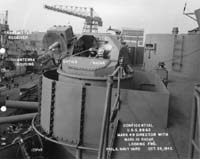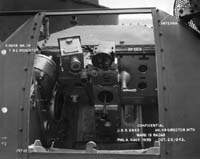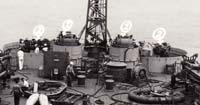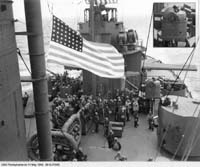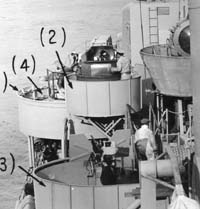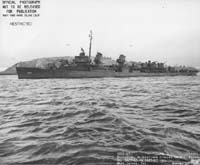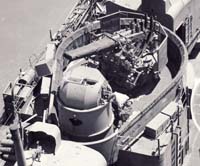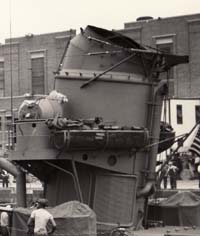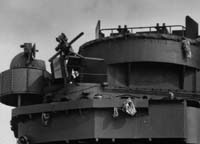Mark 49 Gun Director
|
Documents |
Gallery |
Data Tables
In the years leading up to the second world war, many countries grappled with the problem of making anti-aircraft fire more accurate. The speed of an aircraft, plus its distance from a gun meant that if a gunner simply put the sites directly on the plane and fired, the shells would always fall behind the aircraft and miss. Additionally, smoke and vibration from the gun could make the target harder to see and follow. The solution that many world navies chose was a gun director, mounted near the gun, that could accurately determine range, vector, and speed. Early units were purely optical in nature, but by the end of the war state-of-the-art included radar powered units that could control multiple gun mounts at once. The Mk 49 director was a short-lived anti-aircraft fire director used on some US warships in the middle to late phase of World War II. It was a replacement for the earlier Mk 45, which had turned out too large, heavy, and complex for most shipboard installations. The Mk 49 itself, however, suffered from high complexity and maintenance needs itself, and the success of the simpler Mk. 51 design caused its withdrawl starting in October of 1943. Unlike the Mk 51, wherein the operator stood behind a pedestal-mounted unit and aimed it by turning and tilting with his arms and body, the operator sat inside an enclosed ball with an opening at the top front. Entry was through a hatch on the top rear, and once energized the ball portion would rotate on two axis for train and elevation. Originally designed to be used with the 1.1" mounts early in the war, they were mainly used with the twin and quad 40mm anti-aircraft mounts that replaced the quad 1.1" mounts in 1942. The one advantage the Mk 49 had over the Mk 51 was that radar could be mounted, allowing for directing during attacks within periods of night time or low visibility. For this reason, radar equipped units were kept on some larger ships until later in the war, when newer systems such as the Mk 57 and 63 came online. The radar, when mounted, was always to the right of the operator on the side near the pivot point. Two types of radars were carried although for all practical purposes they would be indistinguishable in conventional ship modeling scales. Schematics for the Mk 49 have not, at this time, been located, but some details are known from the textual records which have been located. If a Mk49 was to be encased in a splinter-shielded tub, minimum diameter of 6', was called for, and it was to be built in segments to facilitate maintenance. The maximum height for the tub was 3' to allow the Mk 49 to depress enough to be used during periods of moderate rolling. Nearly 350 were delivered before installations were halted in October of 1943. The first 269 were built without radar, nearly 50 with the Mk 11 radar, and an unknown number, possibly the balance (roughly 30), with the Mk 19 radar. A November 1944 Bureau of Ordnance letter stated that ships had been authorized to replace the Mk 49 with the Mk 51 and that all directors no in use afloat or in shore activities (training facilities for the most part) should be scrapped. Once the viewer is familiar with the "R2D2" is appearance of the Mk 49 and the locations they were normally mounted, it is generally not too difficult to locate them and differentiate between somewhat similar sillouettes such as searchlights. Below is a gallery of photos showing some of the variations of the unit and installations, as well as lists of ships that we know carried the Mk 49. When specific dates are known for the installation or removal they are given, or a specific date that we know that they were at least present; the modeler or research may use yard visits to guess at the installation and removal dates in some cases. Schematics have not been located at this time, but thanks to the help of others we know that the mount's working circle was 8-ft, 2-in and Max overall height was 6-ft, 11-in. There were six different versions, used for different purposes and with different characteristics: Mk 49 Mod 1 440 VAC (Used on quad 1.1" guns)Mk 49 Mod 2 230 VDC (Used on quad 1.1" guns) Mk 49 Mod 3 115 VDC (Used on quad 1.1" guns) Mk 49 Mod 4 440 VAC (Used on twin or quad 40mm guns) Mk 49 Mod 5 230 VDC (Used on twin or quad 40mm guns) Mk 49 Mod 6 115 VDC (Used on twin or quad 40mm guns) If you have any corrections or additions, please contact the webmaster of this site or Tracy White. |
|
Documents: |
| Aircraft Carriers | Battleships | Cruisers | Minelayers | Destroyers |
Aircraft Carriers
| Essex Class | ||||
|---|---|---|---|---|
| Ship | # of Mk. 49s | Installed | Known dates: | Removed |
| CV-9 Essex | 2 (above Bridge & between aft island 40mms | Commissioned | ~March 1944; | |
| CV-11 Intrepid | 1 (Behind #2 twin 5" mount & between aft island 40mms) | Commissioned | - | after shakedown? |
| CV-16 Lexington | 2 (Above Pilot House and ???) | Commissioned | - | until April-May '45 Overhaul |
Battleships
| Pennsylvania Class | ||||
|---|---|---|---|---|
| Ship | # of Mk. 49s | Installed | Known dates: | Removed |
| BB-38 Pennsylvania | 2 | January, 1943 | June?/July? 1943 | |
| Tennessee Class | ||||
|---|---|---|---|---|
| Ship | # of Mk. 49s | Installed | Known dates: | Removed |
| BB-43 Tennessee | 2 (inboard #3 & 4 twin 5" mounts) | January, 1943 - ?? | Before Jan, 1944 | |
| South Dakota Class | ||||
|---|---|---|---|---|
| Ship | # of Mk. 49s | Installed | Known dates: | Removed |
| BB-60 Alabama | 2 (One Above bridge, port, On aft, stbd stern quad 40mm) |
Commisioned | ||
| Iowa Class | ||||
|---|---|---|---|---|
| Ship | # of Mk. 49s | Installed | Known dates: | Removed |
| BB-61 Iowa | 4? | ? | ? | ? |
| BB-62 New Jersey | 4 | ? | October, 1943 | ? |
Cruisers
| Omaha Class | ||||
|---|---|---|---|---|
| Ship | # of Mk. 49s | Installed | Known dates: | Removed |
| CL-4 Omaha | 2 | February, 1943 | ||
| CL-12 Marblehead | ? | October, 1942 | ||
| Northampton class | ||||
|---|---|---|---|---|
| Ship | # of Mk. 49s | Installed | Known dates: | Removed |
| CA-29 Chicago | 2 (stbd superstructure, port stack) | December '42 | lost with ship, Jan 30, 1943 | |
| New Orleans Class | ||||
|---|---|---|---|---|
| Ship | # of Mk. 49s | Installed | Known dates: | Removed |
| CA-34 Astoria | >=2 | June '42 | ||
| Cleveland Class | ||||
|---|---|---|---|---|
| Ship | # of Mk. 49s | Installed | Known dates: | Removed |
| CL-60 Santa Fe | 2 | |||
| Baltimore Class | ||||
|---|---|---|---|---|
| Ship | # of Mk. 49s | Installed | Known dates: | Removed |
| CA-68 Baltimore | 2 | February, 1943 | ||
Minelayers
| Terror Class (Mk 45s) | ||||
|---|---|---|---|---|
| Ship | # of Mk. 45s | Installed | Known dates: | Removed |
| CM-5 Terror | 2 (above bridge [Mk45s?]) | Operation Torch | ||
Destroyers
| Farragut class | ||||
|---|---|---|---|---|
| Ship | # of Mk. 49s | Installed | Known dates: | Removed |
| DD-348 Farragut | 2 | December, 1943 | ||
| DD-350 Hull | 2 | ? | May, 1944 | August-November, 1944 |
| DD-351 MacDonough | 2 | Jan-Sept, 1943 | ||
| Benson/Gleaves class | ||||
|---|---|---|---|---|
| Ship | # of Mk. 49s | Installed | Known dates: | Removed |
| DD-433 Gwin | 2 | 16 February 43 @ MINY | ||
| DD-453 Bristol | 1 + one Unk | 7 January 1943 | ||
| DD-607 Frazier | 2 | 5 August 1943 … Mk 51's by 26 September 1943 | ||
| DD-626 Satterlee | 2 | 22 September 1943 | ||
| DD-628 Welles | 2 | 10 November 1943 | ||
| DD-638 Herndon | 2 | 30 March 1943 | ||
| DD-639 Shubrick | 2 | 24 March 1943 | ||
| DD-641 Tillman | 1 + one Mk 51 | 14 August 1943 | ||
| DD-647 Thorn | 2 | 30 March 1943 & 28 May 43 … Mk 51's by Jan 44 | ||
| DD-648 Turner | 2 | April 1943 & 23 August 43 … ship Lost 2 Jan 44 | ||
| Fletcher class | ||||
|---|---|---|---|---|
| Ship | # of Mk. 49s | Installed | Radar(s) | Removed |
| DD-465 Saufley | 1 | September 1942 | None | September 1944 |
| DD-466 Waller | 1 | November 1942 | None | September 1944 |
| DD-470 Bache | 1 | December 1942 | None | November 1944 |
| DD-473 Bennett | 3 | March 1943 | None | November 1944 |
| DD-474 Fullam | 3 | March 1943 | None | About September 1944 |
| DD-513 Terry | 1 | January 1943 | None | November 1944 |
| DD-514 Thatcher | 1 | February 1943 | None | About November 1944 |
| DD-515 Anthony | 1 | February 1943 | None | November 1944 |
| DD-516 Wadsworth | 3 | March 1943 | None | November 1944 |
| DD-517 Walker | 3 | April 1943 | None | About January 1945 |
| DD-519 Daly | 3 | March 1943 | None | About January 1945 |
| DD-520 Isherwood | 3 | April 1943 | None | Before August 1944 |
| DD-521 Kimberly | 3 | May 1943 | None | Before October 1944 |
| DD-522 Luce | 3 | June 1943 | Two Mk 11s, September 1943 | About August 1944 |
| DD-527 Ammen | 1 | March 1943 | None | Between Jun '44 and Jan '45 |
| DD-528 Mullany | 1 | April 1943 | None | May-June 1945 |
| DD-529 Bush | 3 | May 1943 | None | Before June, 1944 |
| DD-530 Trathen | 3 | May 1943 | None | About November, 1944 |
| DD-531 Hazlewood | 3 | June, 1943 | None | May-June 1945 |
| DD-533 Hoel | 3 | July, 1943 | None | Before August, 1943 |
| DD-534 McCord | 3 | August, 1943 | None | About July, 1945 |
| DD-535 Miller | 3 | August 1943 | Two Mk 11/19s, Sept 1943 | After Feb, 1945 |
| DD-537 The Sullivans | 3 | Spetember, 1943 | None | About December, 1943 |
| DD-544 Boyd | 1 | May, 1843 | None | Before January, 1944 |
| DD-546 Brown | 3 | July, 1943 | None | ?? |
| DD-550 Capps | 3 | June, 1943 | Three Mk 11, August 1943 | Before March, 1944 |
| DD-551 David W. Taylor | 3 | September, 1943 | Two Mk 11/19, Oct 1943 | ?? |
| DD-554 Franks | 3 | July, 1943 | Unknown | Between October-December, 1943 |
| DD-556 Hailey | 3 | Septmeber | Two Mk 11/19, Oct 1943 | ?? |
| DD-575 McKee | 3 | March, 1943 | None | Before December, 1944 |
| DD-576 Murray | 3 | April, 1943 | None | About November, 1944 |
| DD-577 Sproston | 3 | May, 1943 | None | ?? |
| DD-580 Young | 3 | Juy, 1943 | Two Mk 11/19, August 1943 | Before September, 1944 |
| DD-581 Charrette | 3 | May, 1943 | Two Mk 11 | After February, 1945 |
| DD-582 Conner | 3 | June, 1943 | 1/2 Mk11/19 | ?? |
| DD-583 Hall | 3 | July, 1943 | 2 Mk 11, August, 1943 | December 1943 |
| DD-587 Bell | 3 | March, 1943 | None | ?? |
| DD-588 Burns | 3 | April, 1943 | 1/2 Mk 11, August, 1943 | ?? |
| DD-589 Izard | 3 | May, 1943 | 2 Mk11, September, 1943 | ?? |
| DD-630 Braine | 3 | May, 1943 | None | ?? |
| DD-642 Hale | 3 | June, 1943 | 2/3 - Mk 11/19 - September 1943 |
?? |
| DD-644 Stembel | 3/2 | July, 1943 | None | 2 in 1944 |
| DD-650 Caperton | 3 | July, 1943 August 1943 |
2, then 3 Mk 11 by August 1943 |
1945?? |
| DD-657 Charles J. Badger | 3 | July 1943 | 2 Mk 11, August, 1943 | ?? |
| DD-659 Dashiel | 1 | March, 1943 | None | After January, 1944 |
| DD-667 Chauncey | 3 | May, 1943 | None | About 1944 |
| DD-669 Cotten | 3 | July 1943 | 2 Mk11, August, 1943 | ?? |
| DD-671 Gatling | 3 | August, 1943 | 2 Mk 11/19, September, 1943 | ?? |
| DD-673 Hickox | 3 | September, 1943 | 2 Mk 11/19 October, 1943 | ?? |
| DD-674 Hunt | 3 | September, 1943 | None | October, 1943 |
| DD-675 Lewis Hancock | 3 | September, 1943 | 2 Mk19, October, 1943 | ?? |
| DD-681 Hopewell | 3 | September, 1943 | 2 Mk19, October 1943 | ?? |
| DD-685 Picking | 3 | September, 1943 | None | ?? |
| DD-688 Remey | 3 | September, 1943 | 2 Mk11/19, October, 1943 | ?? |
Additional Resources
"Operational Characteristics of Radar Classified by Tactical Application" - Navy History & Heritage Command
The Mechanical Analog Computers of Hannibal Ford and William Newell- PDF
Interview of Ivan Getting, MIT - PDF
Rick E. Davis
AD Baker
Ron Smith
